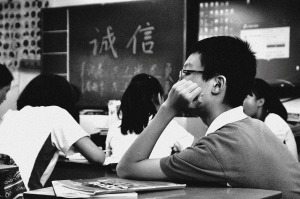My days of school were filled with memorizing dates to pass the test in history. I needed to remember formulas to solve equations in Math of which I could not even make sense, and scientific terms that were hard to say. My textbooks and medium of instruction were in English, not my native tongue. Multiple choice and matching types of tests were reflections of my understanding. The results indicated how I ranked in my class and whether I was a high achiever, an achiever or a low achiever. Then, a national test was given to every graduating student to qualify for a university admission. These tests that I came to know “defined” my capabilities as a person.
my understanding. The results indicated how I ranked in my class and whether I was a high achiever, an achiever or a low achiever. Then, a national test was given to every graduating student to qualify for a university admission. These tests that I came to know “defined” my capabilities as a person.
In this day and age, many other forms of assessment materials have been designed for different purposes. However, there remains a number of achievement test given especially to those who are intending to pursue a degree in university. The history of this type of test dates back in 604 to 6017 during the reign of Emperor Yang in China. Yan instituted the Imperial Examination system in order to “sort the multitudes of men seeking civil service jobs” (Hammond, n.d). Just like my home country, China also requires students to pass a national exam called, Gaokao in order to take a degree in university. It was deemed a passport to professional work. Regardless of economic status, everyone work to prepare for this exam. It requires a lot of money and preparation to take this exam. Moreover, the great test-taking ability of Chinese students was shown in their top performance at the Program for International Student Assessment (PISA). Gibbord (2010) shares the insight of a middle school principal in Shanghai that although they perform well in an internationally benchmarked exam, China still needs reforms in the educational system towards analytical and critical thinking. Educators expressed that these excellent test-takers still do not qualify in the workforce that needs creative managers of the global companies. However, many believe that as long as “Gaokao” remains the measure for a student to gain further education, the shift to a different educational system is still far from happening.
The experience of China in implementing an assessment system and their purposes for implementation are still common in many countries around the globe. It is about time to look at assessments and their use in the whole spectrum of the global economy. We have to consider the development of the whole child ( ASCD, 2014) and meaningful methods of assessment to a sustainable future driven by mature, and healthy individuals.
many countries around the globe. It is about time to look at assessments and their use in the whole spectrum of the global economy. We have to consider the development of the whole child ( ASCD, 2014) and meaningful methods of assessment to a sustainable future driven by mature, and healthy individuals.
References:
ASCD (2014). Whole School, Whole Community, Whole Child. ASCD-CDC Retrieved from http://www.ascd.org/ASCD/pdf/siteASCD/publications/wholechild/wscc-a-collaborative-approach.pdf
Education Reforms in China: What the Educators Think (2010). OECD Insights. Retrieved from http://oecdinsights.org/2010/03/19/education-reform-in-china-what-the-educators-think/
Gibbord, R. (2010). Call for Reform. NPR Retrieved from http://www.npr.org/2010/12/29/132416889/chinese-top-in-tests-but-still-have-lots-to-learn
Hammond, B. (n.d). Great Test Scores, Bad Schools: A Cautionary Tale From China. China and Testing. Retrieved from http://www.isacs.org/misc_files/Hammond%20article.pdf

April 11, 2015 at 10:14 pm
Stereotypically, I think most people believe individuals of Asian descent are usually smarter than Americans. Based off of what you have just said about the importance of test preparation for the Gaokao, I can see why. However, it seems a little harsh to have to take a test to see if you qualify for professional work.
LikeLike
April 13, 2015 at 1:42 am
Pamela, thank you for sharing this story! How interesting that everyone prepares for and takes the same exam in order to qualify for professional work, regardless of economic status. At what age do folks usually take this exam? Would one be able to take it more than once?
LikeLike
April 13, 2015 at 3:41 am
It about the age when they finish high school so around 17 to 19. Yes, they can take it again, but for those who are financially challenged, because it requires the mother to be in the place where they study and eventually take the exam to support the student, it takes a lot of resources. One story I read, the father was a factory worker, the mother quit her job to be with the son, and after a year of preparation, he did not pass it, so he opted to work in a factory too like the father.
LikeLike